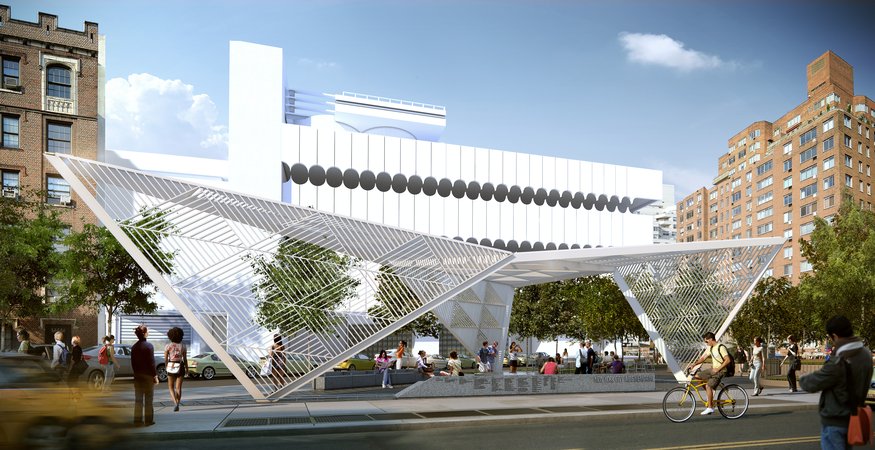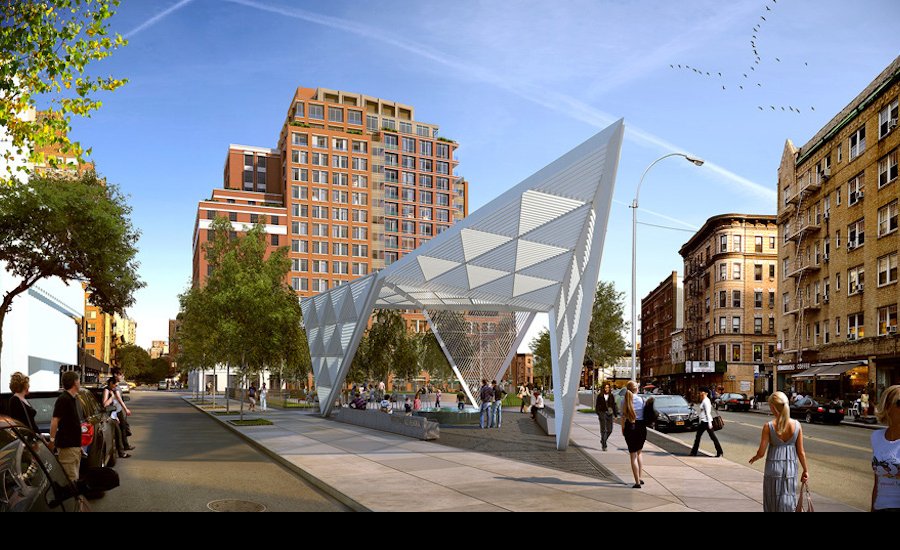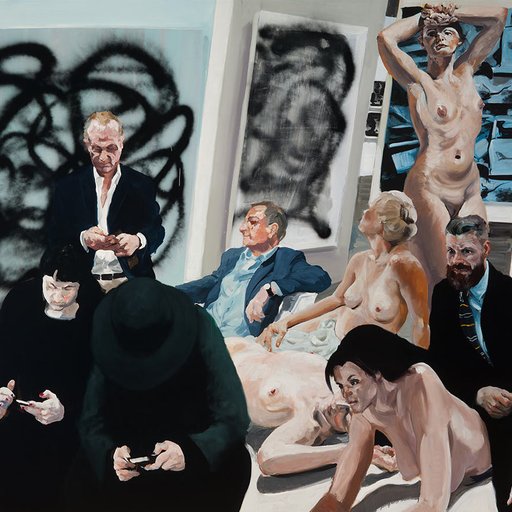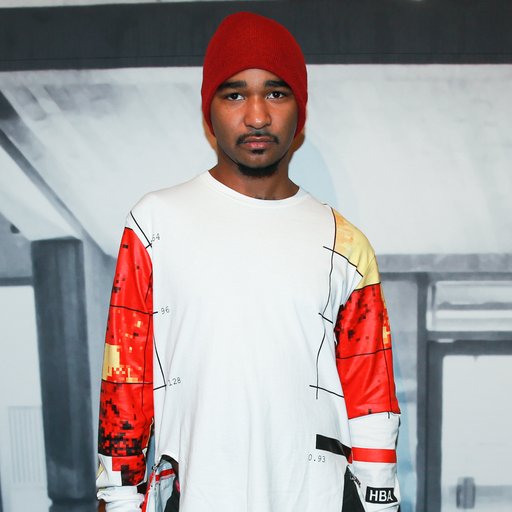It’s been nearly four decades since the AIDS crisis descended upon New York, and despite losing more than 100,000 men, woman, and children to the pandemic, the city has lacked a visible public memorial in recognition—that is, until now. Last week, the New York City AIDS Memorial was unveiled in a West Village public park adjacent to the former St. Vincent’s Hospital , which acted as a harrowing ground zero during the height of the outbreak, having housed the very first and largest AIDS ward in the country.
In remembrance of those lost, and in tribute to the heroic effort of healthcare professionals and activists who have been (and continue to be) crucial to the fight against the disease, the memorial acts as a monument, a gathering place, and also an inspiration for a continued effort to end AIDS. Founded by Christopher Tepper and Paul Kelterborn— and made possible by an 18-person board of directors chaired by Phaidon ’s own Keith Fox— the memorial has been underway for almost six years with the hope that the park will mark both the place where the AIDS epidemic started, and hopefully, will end: here in New York.

Designed by the architects of Studio ai , the white steel canopy structure hovers over a granite plaza designed by the politically outspoken visual artist Jenny Holzer , who engraved the spiraling pavers with sections from Walt Whitman’ s Song of Myself. In the middle lies a reflecting pool that in the coming weeks will be surrounded by granite benches.
During the emotional unveiling ceremony, Mayor Bill de Blasio spoke to an overflowing crowd of people holding inspirational signs and banners, many of whom had been personally involved with the fight against HIV; some passed out flyers for the candlelight vigils that would follow. Speakers at the ceremony also included poet Timothy Duwhite , author Kamilah Aidsha Moon , and HIV-positive city councilman Corey Johnson .
To join in paying tribute to the project's cause and to the memorial's historic inauguration, Artspace approached over a dozen cultural luminaries who were involved in the project to ask them a single question: Why does the New York City AIDS Memorial matter? Here, below, are their moving answers.
KEITH FOX
CEO, Phaidon
“Imagine New York City if Michael Bennett could write new musicals. If Keith Haring , David Wojnarowicz, Peter Hujar , Robert Mapplethorpe , and Paul Thek were still making art. If Tom Stoddard and Vito Russo continued to shine the light on inequalities. If my sister's best friend, Stone Boswell, could still make my family laugh. In creating the New York City AIDS Memorial, we were inspired to honor the 100,000 New Yorkers who died from this disease, and to ensure that their memory, and our shared history, is not forgotten.”
RALPH LAUREN
Designer
“The New York City AIDS Memorial is an important and meaningful tribute not only to all those lost to the AIDS epidemic, but also to the caregivers and activists who continue to make such a difference. This beautiful park and its emotional centerpiece are important reminders to continue our vigilance and, most of all, to educate new generations about the history of AIDS to ensure a future without it.”
JENNY HOLZER
Artist
“I came to New York in the late ‘70s and was there through the ‘80s, and that was the time [of the epidemic.] I worked in a restaurant in which two of my fellow waitpeople became sick and died shortly after our time together there. I knew any number of other people who became ill and passed away much too fast. My cohort wondered if we were going to die. I am forever sorry about how many people were lost, and I am worried to death about how many other people are sick and becoming infected…. It’s grievously sad that it took so long [for a memorial to be made]. It’s not completely surprising, though, if you think how much shame and stigma was originally attached, and then that was followed by so much grieving, which can, for a while, be enervating. But here’s to the people behind the memorial for making it happen.”
MARK LEE
CEO, Barney's
“Both personally and historically it's important to remember all those we lost. For young and future generations it’s important for the educational value.”
SIR ELTON JOHN
Founder, Elton John AIDS Foundation
“The AIDS epidemic will go down as a defining chapter in the history of this nation. We allowed our fear of disease to turn us against suffering people who should have had our help and our compassion. Stigma and discrimination rode roughshod over science and the public good. But we came together, and against terrible odds, we began to turn the tide. May this beautiful memorial become a place for memory, for healing, for education, and for unity in our continuing effort to achieve a world without AIDS.”
SIMON DOONAN
Author and Creative Ambassador-at-Large, Barney's
“Many of my pals and boyfriends died during the height of the AIDS epidemic. I have always been haunted by the notion that these brave souls might be totally forgotten. As a result, the NYC AIDS Memorial has enormous emotional significance.”
ANDY COHEN
Executive Producer at Bravo
"With St. Vincent's replaced by a God-Awful Condo, how fitting that across the street we have a spot to remember and mourn the beautiful people we lost in the plague that changed the course of this great city and the world."
SCOTT P. CAMPBELL
Executive Director, Elton John AIDS Foundation
“The New York City AIDS Memorial preserves the history of New York’s unique role in the fight against AIDS, honors the memory of the many precious lives lost to this terrible disease, and renews awareness and inspires action to end AIDS once and for all. Everyone at the Elton John AIDS Foundation is proud and honored to support this important memorial.”
DAVID FURNISH
Chairman, Elton John AIDS Foundation
“The New York City AIDS Memorial, created on the site of the first AIDS ward in New York City at St. Vincent’s Hospital, gives us all a hallowed space to remember the many people we have lost, to reflect on the lessons we have learned about the destructive power of stigma and the healing power of compassion, and to renew our determination to end AIDS for every person in every place.”
MICHAEL ARAD
9/11 Memorial architect
“During my freshman year in college in 1988 I took a theatrical lighting class and found myself on the crew of a production of The Normal Heart . Sitting through one rehearsal after another opened my eyes to the suffering that I, like so many others, had ignored. My hope is that this memorial will shed a light on this suffering and help us see suffering in others today. It’s easy to close our eyes; I hope this memorial will help us open them.”
GUILLERMO CHACÓN
President, Latino Commission on AIDS
"The memorial helps me breath easier when I think about all the people that I lost due to HIV/AIDS. I don’t know if you know, but over 100,000 people died just in the city of New York. It is very hard to talk to a New Yorker and have them not know somebody that was lost. Even more importantly, we are still fighting this disease! Personally, it means so much to walk inside the memorial and know that finally there is a tribute to this war, to know that there is a human cost that we pay. This is a testimony and a reminder that we need to do more, especially to remove homophobia, transphobia, and AIDS-phobia. This is a chronic condition. We are blessed inside of the United States and Puerto Rico to have access to treatment, because if people aren’t connected to care we know that HIV will be undetectable. Only 40 percent of people living with HIV—an estimated 1.2 million people—are receiving care. We have a ways to go. For Hispanics and Latinos in New York, there are close to 34,000 who are fighting this epidemic today. This is a testimony to that."
DIANE VON FURSTENBERG
Designer
"It is important to remember so no loss of life gets forgotten.”
BRUCE BOZZI
The Palm restaurateur
“It's human nature to forget. The AIDS Memorial stands exactly where many people who lost their lives at St. Vincent's looked out their window for the last time. This Memorial not only pays honor to those whose lives were taken, but the men and women who fought to be heard against the discrimination of this disease, the denial, and the fight for fundamental human rights. That corner of New York City will remind generations to come, never to forget and to honor the courage, the passion and the anger of a disease that ravaged the world and our city at the end of the 20th century.”
STEVEN KOLB
President and CEO, Council of Fashion Designers of America (CFDA)
“The fashion industry lost so many talented people to AIDS. To now see them counted among others and remembered with the New York City AIDS Memorial is moving and sobering.”
DARREN WALKER
President, The Ford Foundation
“I came to New York right after law school in the late 1980s and I remember the horrors and heartbreak AIDS ravaged on our city, and particularly on the gay community. I am glad this memorial honors the many lives taken by this insidious, corrosive, devastating disease. At the same time, sites like the New York City AIDS Memorial, or Bryan Stevenson's proposed memorial for the victims of lynching, are so important because these are also tributes to the victims of inequality. We must never forget the way people and communities have suffered because of intolerance or ignorance, and this monument reminds us that we must do better.”



























